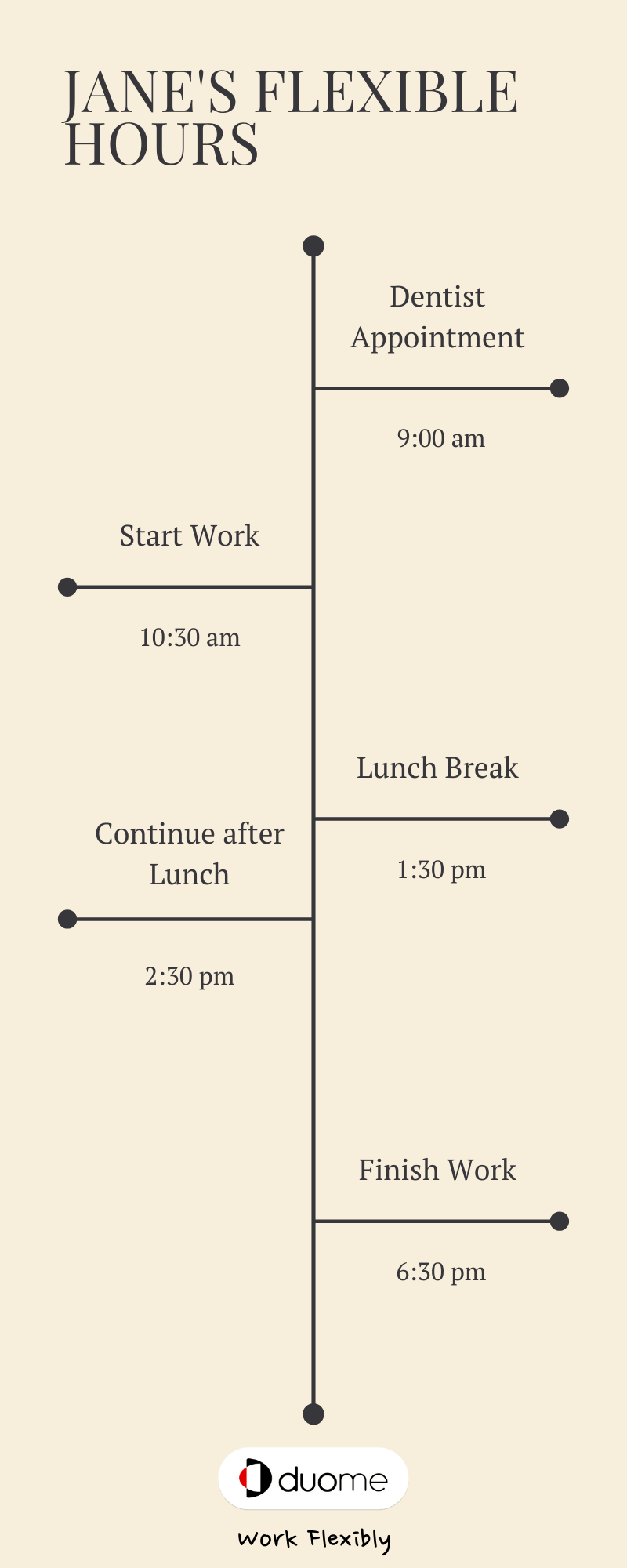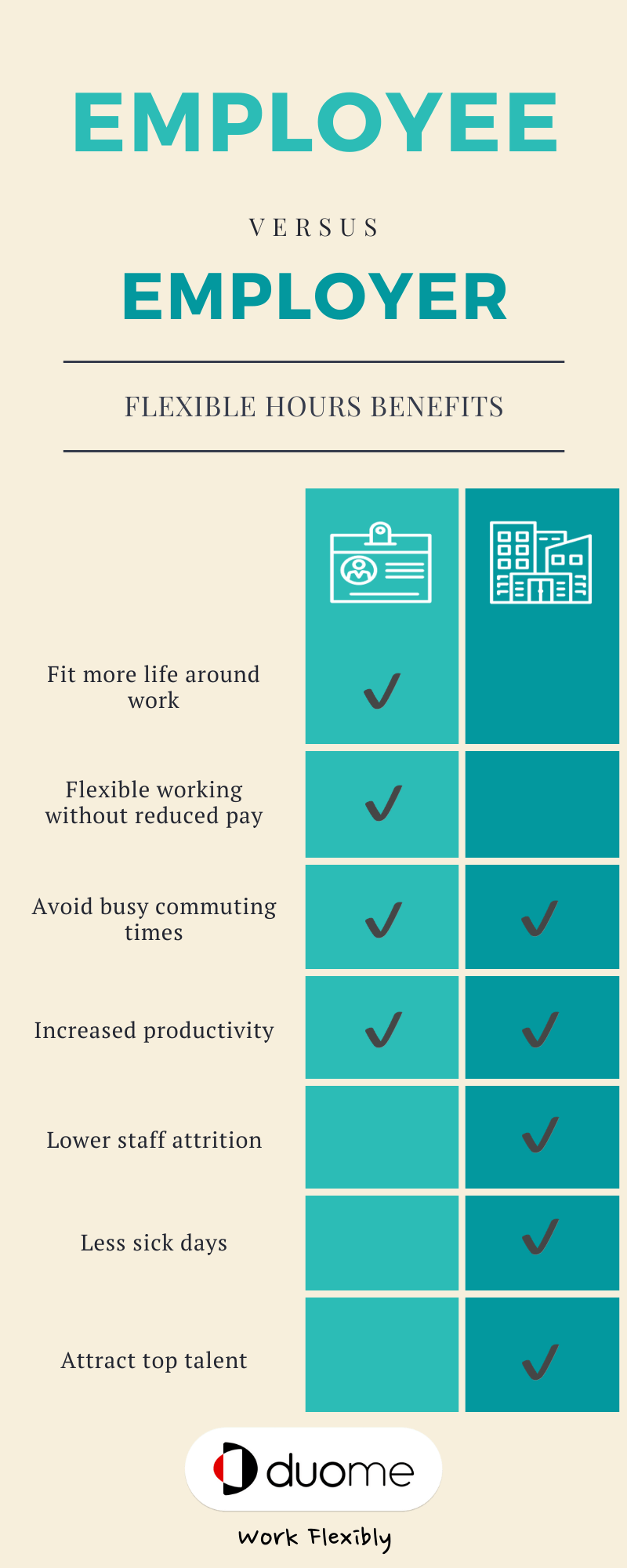Flexible hours are a type of flexible working that enables you to work to a different schedule from what is standard across your company. They give you greater control over your start or finish time whilst still working the same contracted hours. Flexible hours are usually available at the employee’s discretion around core hours which must be worked, e.g. 10.30 am to 3.30 pm.
If flexible hours are available at your employer, they usually form part of the standard terms of employment so don’t need to be formally requested to have the right to use them.
Flexible Hours Definition
Flexible working hours can be known by different names but are most commonly called flexitime, flextime, flexible schedule, flexible working hours, or occasionally, agile working. Most employer policies that allow them tend to have the same characteristics, namely:
- The employee can adjust their start or end time of their working day
- The employee must work their daily contracted hours
- The employee doesn’t need to request formal approval or a change of contractual terms to have the entitlement to use but may need to notify when they plan to use them
- The employer has a core set of hours they expect the employee to be in the office
The requirement to work your daily contracted hours is different from compressed hours or annualised hours, which both let you adjust the amount you work day to day. These arrangements require formal approval or a change to contract terms such as a Flexible Working Contract. They also require more procedural oversight to ensure the time worked is being captured.
Almost all flexible hours arrangements have a core set of hours that must be worked. This enables the employer to keep a level of control over how early or late someone has to work. This makes sense as many offices are not open 24/7 and also having the support of employees through the majority of the day or during busy times is important for employers.
Flexible Working Hours Examples
In the most simple terms, if you start your day one hour later than is standard, say at 10 am, you will be required to work one additional hour at the end of your day. Depending on how your company measures time in the workplace, some companies allow employees to work through part of their lunch to recover the hour.

Example 1 – Starting work at 10.30 am
Jane has organised a dentist appointment for 9 am on Wednesday, the time she would normally be arriving at work.
Jane works full-time on a 35 hours a week contract with her company standard working hours being 9 am to 5 pm with a one-hour lunch break. Jane’s company supports flexible working hours with a core hours requirement of 10.30 am to 3 pm. Jane doesn’t need to request approval under her companies flexible working policy, so arrives at work at 10.30 am following her dentist appointment. She takes an hour for lunch, requiring her to work until 6.30 pm that day
Note that Jane makes up the hours she needs to work that day and does not spread the hours across different days, which can be done with a compressed hours schedule.
Example 2 – Need to leave at 3.30 pm
John needs to be home when his kids finish school on Wednesday so has to leave the office at 3.30 pm to get home by 4. John works an eight hour day and plans to take a 30-minute lunch break. To leave the office by 3.30 pm, John must start his working day at 7 am to work his 8 hours plus his 30 minutes for lunch.
Flexible Working Hours Advantages
Understanding the advantages of flexible working hours will help you to make the right decision. Additionally, understanding how they can help your employer enables you to sell the benefits.

- Fit more life around work – not everything is scheduled outside of the working day, especially if you have kids. Flexible working hours let you adjust your daily working schedule so you can attend important events or make appointments like dentist visits without taking time off.
- Flexible working without reduced pay – As you work the same amount of hours, you get a level of flexibility without having to reduce your salary.
- Avoid busy commuting times – being able to adjust your start and end time can have a big effect on how busy your commute time is. For instance, Transport for London says the busiest times on its network is between 05:45-08:15 and 16:00-17:30.
- Lower staff attrition – staff members that have flexible working options are less likely to leave their current employer. In this survey, three-quarters of respondents who had flexibility said they would be reluctant to leave to an employer that didn’t also offer flexibility.
- Increased productivity – flexible workers are consistently shown in studies to be more productive. In this study, over 20% of respondents suggested they were much more productive after moving to a flexible schedule.
- Less sick days – companies that support flexible hours report seeing a reduction in workplace absences. In this study, small to medium-sized business were directly using it as an approach to reduce sick days across their staff.
- Attract top talent – flexible working options have been shown to increase applicants particularly females. Zurich insurance increased the number of female applicants it had for positions by offering positions with flexible options.
Frequently Asked Questions
What is a flexible schedule?
A flexible schedule is one of the many names given to flexible working hours. It refers to the fact that people working in this pattern have greater control over their schedule to pick the hours that suit them. This is frequently connected to fully remote employees that are evaluated based on the work they do vs the hours they are in the role. With the advent of hybrid work schedules that manage the location people plan to work each week, schedules are a key part of almost all companies flexible working approach.
What are the disadvantages of flexible working hours?
Flexible hours can create some additional coordination and exacerbate some communication issue through reduced availability for meetings. Individuals can in some cases become a bit detached from the team not working flexible hours and may require more deliberate socialisation to ensure included.
What is a flexible working arrangement?
A flexible working arrangement is a formal contractual change to recognise your change to the location, hours, or amount that you work. Not all flexible working request requires a formal change, your employer may have a broad flexible working policy that supports all employees to have some types of flexibility, such as flexible working hours. Talk with your manager or HR team about what’s available in the first instance.
In Summary
Flexible working hours enable you to pick your start or end time of the working day around a core set of hours such as 10:30 am to 3:30 pm. This gives employees some flexibility around their schedule without having to reduce their pay. This has a number of advantages for employees and employers and is one of the most widely available types of Flexible Working.







